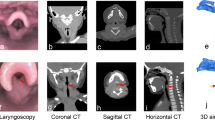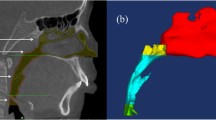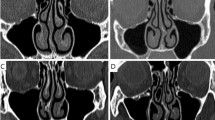Abstract
To analyze airway changes in patients who underwent various types of oral cancer surgery, computational fluid dynamics (CFD) based on 3D reconstruction of the airway was applied. Seventeen patients were included in the study (12 males and 5 females). The mean age was 57.1 years (range 22–78). They showed the highest rate of T2 stage. In neck dissection (ND) performed with the removal of the primary lesion, selective ND had the highest rate (58.2%). The anterolateral thigh (ALT) flap was the most commonly used for reconstruction after the malignant lesion was removed (52.9%). The airways of the patients were remodeled using computed tomographic data, and CFD was applied to the model. The CFD results showed that 47.1% (n = 8) of patients showed deterioration of airway airflow, 23.5% (n = 4) of patients had rapid deterioration, and 29.4% (n = 5) of patients showed remission. The sex and age of the patient, the location and size of the primary lesion, and the type of surgery performed were not significantly correlated with changes in the airway flow rate. A significant reduction in cross-sectional area with a reduction in volume can promote high velocity, resulting in a high-pressure drop to ensure the same flow rate of inhaled air. An increase in volume with reduced height can attenuate undesirable flow and reduce pressure drop in the case of airflow alleviation.
Graphical abstract







Similar content being viewed by others
References
Alcalde LFA, Faria PEP, Nogueira RLM, Chihara L, Sant’ana E (2019) Computed tomography visualizing alterations in the upper airway after orthognathic surgery. J Cranio-Maxillo-Facial Surg Official Publ Eur Assoc Cranio-Maxillo-Facial Surg 47:1041–1045
Beni HM, Mortazavi H, Aghaei F, Kamalipour S (2021) Experimental tracking and numerical mapping of novel coronavirus micro-droplet deposition through nasal inhalation in the human respiratory system. Biomech Model Mechanobiol 20:1087–1100
Beni HM, Mortazavi H, Islam MS (2022) Biomedical and biophysical limits to mathematical modeling of pulmonary system mechanics: A scoping review on aerosol and drug delivery. Biomech Model Mechanobiol 21:79–87
Gokce SM, Gorgulu S, Gokce HS, Bengi AO, Karacayli U, Ors F (2014) Evaluation of pharyngeal airway space changes after bimaxillary orthognathic surgery with a 3-dimensional simulation and modeling program. Am J Ortho Dentofacial Orthopedics: Official Publ Am Assoc Ortho Const Soc Am Board Ortho 146:477–492
Gong X, Li W, Gao X (2018) Effects of craniofacial morphology on nasal respiratory function and upper airway morphology. J Craniofac Surg 29:1717–1722
Hong H, Yeom E, Ji HS, Kim HD, Kim KC (2017) Characteristics of pulsatile flows in curved stenosed channels. PLoS One 12:e0186300
Huang H, Yin H, Wang Y, Chen N, Huang D, Luo X, Yin X, Zheng Q, Shi B, Li J (2020) Computational fluid dynamic analysis of different velopharyngeal closure patterns. Ann Otol Rhinol Laryngol 129:157–163
Itoh H, Katsumata A, Kashimura K, Iida Y, Noguchi T, Sarukawa S, Jinbu Y, Kusama M (2015) Morphological changes of upper airway and dysphasia problems in oral cancer patients with oropharyngeal reconstruction surgery. J Oral Max Surg Med 27:608–613
Jakobsone G, Neimane L, Krumina G (2010) Two- and three-dimensional evaluation of the upper airway after bimaxillary correction of class iii malocclusion. Oral Surg Oral Med Oral Pathol Oral Radiol Endod 110:234–242
Kawakami M, Yamamoto K, Fujimoto M, Ohgi K, Inoue M, Kirita T (2005) Changes in tongue and hyoid positions, and posterior airway space following mandibular setback surgery. J Cranio-Maxillo-Facial Surg Official Publ Eur Assoc Cranio-Maxillo-Facial Surg 33:107–110
Kim MS, Park JH, Lee KY, Choi SH, Jung HH, Kim JH, Lee B (2019) Influence of head and neck position on the performance of supraglottic airway devices: a systematic review and meta-analysis. PloS one 14:e0216673
Liu X, Fan Y, Deng X, Zhan F (2011) Effect of non-newtonian and pulsatile blood flow on mass transport in the human aorta. J Biomech 44:1123–1131
Lucey AD, King AJ, Tetlow GA, Wang J, Armstrong JJ, Leigh MS, Paduch A, Walsh JH, Sampson DD, Eastwood PR, Hillman DR (2010) Measurement, reconstruction, and flow-field computation of the human pharynx with application to sleep apnea, 57: 2535–2548.
Marcussen L, Stokbro K, Aagaard E, Torkov P, Thygesen T (2017) Changes in upper airway volume following orthognathic surgery. J Craniofac Surg 28:66–70
Na JS, Jung HD, Cho HJ, Choi YJ, Lee JS (2019) Computational analysis of airflow dynamics for predicting collapsible sites in the upper airways: a preliminary study. J Appl Physiol 126: 330–340.
Paeng JY, Kim JW, Lee ST (2019) Changes in hyoid bone position and cross-sectional area of pharyngeal airway after oral cancer surgery. Anticancer Res 39:2097–2104
Scheinherr A, Bailly L, Boiron O, Lagier A, Legou T, Pichelin M, Caillibotte G, Giovanni A (2015) Realistic glottal motion and airflow rate during human breathing. Physics 37:829–839
Schwab RJ, Goldberg AN (1998) Upper airway assessment: radiographic and other imaging techniques. Otolaryngol Clin North Am 31:931–968
Shah DH, Kim KB, Mcquilling MW, Movahed R, Shah AH, Kim YI (2016) Computational fluid dynamics for the assessment of upper airway changes in skeletal class iii patients treated with mandibular setback surgery. Angle Orthod 86:976–982
Sittitavornwong S, Waite PD, Shih AM, Cheng GC, Koomullil R, Ito Y, Cure JK, Harding SM, Litaker M (2013) Computational fluid dynamic analysis of the posterior airway space after maxillomandibular advancement for obstructive sleep apnea syndrome. J Oral Maxillofac Surg Official J Am Assoc Oral Maxillofac Surg 71:1397–1405
Song B, Li Y, Sun J, Qi Y, Li P, Li Y, Gu Z (2019) Computational fluid dynamics simulation of changes in the morphology and airflow dynamics of the upper airways in osahs patients after treatment with oral appliances. PloS one 14:e0219642
Song JM, Seo H, Choi NR, Yeom E, Kim YD (2020) Application of computational fluid dynamics analysis after bimaxillary orthognathic surgery. Appl Sci 10: 1676.
Staderini E, Patini R, De Luca M, Gallenzi P (2018) Three-dimensional stereophotogrammetric analysis of nasolabial soft tissue effects of rapid maxillary expansion: a systematic review of clinical trials. Acta Otorhinolaryngologica Italica: Organo Ufficiale Della Societa Italiana Di Otorinolaringologia e Chirurgia Cervico-Facciale 38:399–408
Staderini E, Patini R, Camodeca A, Guglielmi F, Gallenzi P (2019) Three-dimensional assessment of morphological changes following nasoalveolar molding therapy in cleft lip and palate patients: a case report, Dentistry J, 7(1):27
Suga H, Iwasaki T, Mishima K, Nakano H, Ueyama Y, Yamasaki Y (2021) Evaluation of the effect of oral appliance treatment on upper-airway ventilation conditions in obstructive sleep apnea using computational fluid dynamics, Cranio : J Craniomandibular Practice, 39(3):209–217. https://doi.org/10.1080/08869634.2019.1596554
Xia G, Tawhai MH, Hoffman EA, Lin CL (2010) Airway wall stiffening increases peak wall shear stress: a fluid-structure interaction study in rigid and compliant airways. Ann Biomed Eng 38:1836–1853
Yajima Y, Oshima M, Iwai T, Kitajima H, Omura S, Tohnai I (2017) Computational fluid dynamics study of the pharyngeal airway space before and after mandibular setback surgery in patients with mandibular prognathism. Int J Oral Maxillofac Surg 46:839–844
Yu CC, Hsiao HD, Tseng TI, Lee LC, Yao CM, Chen NH, Wang CJ, Chen YR (2012) Computational fluid dynamics study of the inspiratory upper airway and clinical severity of obstructive sleep apnea. J Craniofac Surg 23:401–405
Zhao M, Barber T, Cistulli P, Sutherland K, Rosengarten G (2013) Computational fluid dynamics for the assessment of upper airway response to oral appliance treatment in obstructive sleep apnea. J Biomech 46:142–150
Author information
Authors and Affiliations
Corresponding authors
Additional information
Publisher's Note
Springer Nature remains neutral with regard to jurisdictional claims in published maps and institutional affiliations.
Rights and permissions
About this article
Cite this article
Choi, NR., Seo, H., Yeom, E. et al. Application of computational fluid dynamics for the analysis of postoperative airway changes in oral cancer patients. J Vis 25, 1063–1073 (2022). https://doi.org/10.1007/s12650-022-00835-w
Received:
Revised:
Accepted:
Published:
Issue Date:
DOI: https://doi.org/10.1007/s12650-022-00835-w




